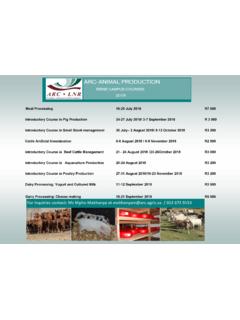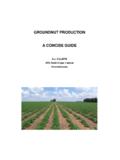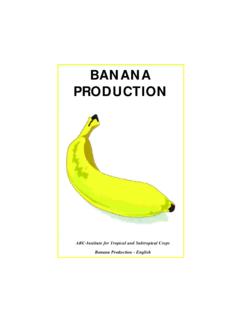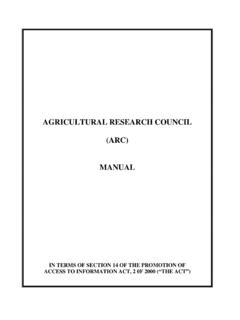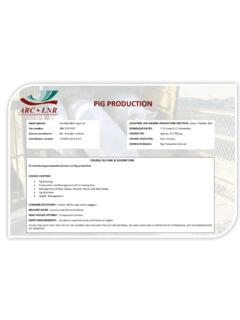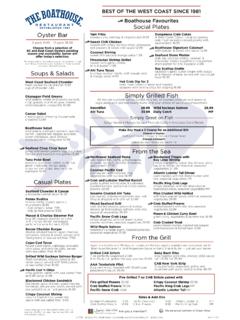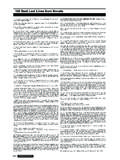Transcription of Production guidelines for Cowpeas
1 Production guidelines for CowpeasDJULFXOWXUH IRUHVW U\ ILVKHULHV&GRCTVOGPV #ITKEWNVWTG (QTGUVT[ CPF (KUJGTKGU4'27$.+% 1( 5176* #(4+%#DEPARTMENT OF AGRICULTURE, FORESTRY AND FISHERIESD irectorate Plant ProductionnProduction guidelines for Cowpeas2011 Compiled by Directorate Plant Production in collaboration with the ARCO btainable from Resource Centre Directorate Agricultural Information Services Private Bag X144, Pretoria, 0001 South Africa The web: by Directorate Agricultural Information Services Department of Agriculture, Forestry and Fisheries Private Bag X144, Pretoria, 0001 South AfricaFurther information or contacts Directorate Plant Production , Division Indigenous Crops Tel: 012 319 6079 Fax: 012 319 6372 E-mail: I: General aspects.))))]
2 1 1. Classification .. 1 2. Origin and 1 3. Production 1 4. Major Production areas in South 3 5. Varieties and 3 6. 5 7. Climatic 5 8. Soil 6 PART II: Cultivation practices .. 7 1. 7 2. Soil 7 3. Field layout and 7 4. 7 5. Fertilisation .. 8 6. Irrigation .. 8 7. Weed 8 8. Pest 8 9. Disease 9 10. Other cultivation 10 11. 11 PART III: Post-harvesting handling .. 12 1. 12 2. Post-harvesting 12 3.
3 12 4. 13 5. 13 6. 13 7. 13 PART IV: Production 14 PART V: 151 PART I: General aspects1. CLASSIFICATIONS cientific name: Vigna unguiculataCommon names:Afrikaans akkerboon, swartbekboon, boontjie, koertjie, dopboontjie English cowpea , bachapin bean, black-eye bean or pea, catjang, china pea, cowgram, southern peaSepedi dinawa (plural), monawa, nawaShangaan dinaba, munaoa, tinyawa Setswana dinawa, nawa-ea-setswanaTshivenda munawa (plant), nawa (fruit) isiZulu imbumba, indumba, isihlumaya2.
4 ORIGIN AND DISTRIBUTIONC owpea (Vigna unguiculata (L.) Walp) is one of the most ancient human food sourc-es and has probably been used as a crop plant since Neolithic times. A lack of ar-chaeological evidence has resulted in contradicting views supporting Africa, Asia and South America as origin. Some literature indicates that cowpea was introduced from Africa to the Indian subcontinent approximately 2 000 to 3 500 years ago, at the same time as the introduction of sorghum and millet, while others state that before 300 BC, Cowpeas had reached Europe and possibly North Africa from Asia.
5 Speculations are that the Northern part of the Republic of South Africa (former Transvaal region) was the centre of speciation of V. unguiculata, owing to the presence of most primitive wild varieties. They further hypothesised that the species moved northwards from the Transvaal to Mozambique and Tanzania, where the subspecies pubescens evolved. cowpea is now grown throughout the tropics and subtropics and has become a part of the diet of about 110 million people. cowpea is believed to have originated from West Africa by some workers, because both wild and cultivated species abound in the region.
6 Others believe that it originated from Southern Africa. Its Production has spread to East and Central Africa, India, Asia, South and Central Production LEVELSS outh AfricaA large producer of Cowpeas is small-scale farmers under dryland farming condi-tions. There are no records with regard to the size of area under Production and the quantities is estimated that the annual world cowpea crop is grown on 12,5 million ha, and the total grain Production is 3 million tons altough only a small proportion enters the inter-national trade.
7 West and Central Africa is the leading cowpea producing region in the world; this region produces 64 % of the estimated 3 million tons of cowpea seed pro-duced annually. Nigeria is the world s leading cowpea producing country, followed by Brazil. Other countries in Africa, West Africa, are Nigeria, Senegal, Ghana, Mali and Burkina Faso. Ghana, Niger, and Cameroon are significant producers. The ma-jor Production areas elsewhere in the world are Asia (India, Myanmar) and the Amer-icas (USA, Brazil, West Indies).
8 Of the developed countries, only the USA is a sub-stantial producer and exporter. The cowpea is one of the mandated crops addressed by the International Institute of Tropical Agriculture, Ibadan, Nigeria. Worldwide cow-pea Production in 1981 was estimated at 2,7 million tons from 7,7 million ha. That notwithstanding, based on information available from Food and Agricultural Organi-zation (FAO), it was estimated that more than 3,3 tons of Cowpeas were produced worldwide in 2000 from at least 12,5 million ha.
9 cowpea Production is widely distrib-uted throughout the tropics, however, Central and West Africa account for more than 64 % of the area with about 8 million ha, followed by about 2,4 million ha in Central and South America, 1,3 million ha in Asia and 0, 80 million ha in East and Central Africa. cowpea can be regarded as the fulcrum of sustainable farming in semiarid lands. This applies to West and Central Africa. In these regions, the area of cowpea Production extends in a westerly direction from Cameroon through Senegal, lying mainly between 10 N and 15 N, covering the dry savannah (northern Guinea and Sudan savannahs) as well as Sahel zones.
10 There are also a few additional pockets of Production at more southerly latitudes, where the dry savannah agro-ecology pen-etrates closer into the West African coast, as in Ghana and Benin. 3 Province District TownLimpopo Bohlabela Thulamahashe, Hoedspruit, Nkhulu, Vhembe Thohoyandou, Musina, Louis Trichardt, Mutale Mopani Giyani, Duiwelskloof, Tzaneen, Phalaborwa, Thohoyandou, Musina, Louis Trichardt, Mutale Capricorn Polokwane, Bochum, Juno, Dendron, Sekhukhune Jane Furse Waterberg Modimolle, Thabazimbi, Ellisras, NaboomspruitMpumalanga Gert Sibande Ermelo, Secunda, Carolina Nkangala Middelburg, Delmas, Witbank Ehlanzeni Nelspruit, LydenburgNorth-West Central Lichtenburg.
